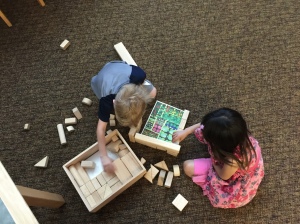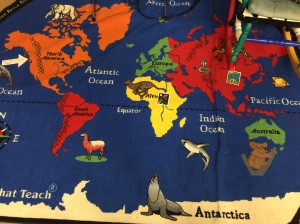After teaching elementary school library for over a decade, one would think there is a set lesson or format I use to map out each school year. It’s often assumed that I do the same thing, year in and year out. After all, why recreate the wheel?
Well, I do. New classes mean new personalities. What worked with one group of children may not work with another. Our annual school learning goals need to be taken into account, as well as curricular, technological, and logistical changes. In short: I never do the same thing exactly the same way each year.
Our K’s traditionally take part in unit studies, but the books, activities, and technologies used change a bit each year. With so many new titles, apps, and websites, there will always be new ways to foster learning. The questions used in lessons change, too, since I work to get better at incorporating critical-thinking, claim-evidence-reasoning questions. Adding strategies and ideas from the Maker movement into our lessons (when reasonable) is also a goal.
The first six weeks tend to follow a pretty set format regarding skills introduced and overall expectations. Most of my first six weeks is explained here. Note: for the lessons listed, students visit library 1x week for 40 minutes.
- Week 1
- Week 2
- Week 3
- Week 4
- Week 5
- Week 6
- Week 1: Play I-Spy in the Library game, learn where to sit (assigned spot) and how to sit (hands/feet to self), get to know one another with the Squishy Ball, listen to one story (first author study), show where to sit at the end of the lesson (the line near the door…no chairs/table spots), learning goal: what does an author do?
- Week 2: Review where/how to sit, play make-believe games with Mr. Tiger (large stuffed animal mascot who I “talk” to), listen to story, barcodes & passes, self check-out (books on top of shelves only), learn whose responsibility it is to bring back book (students, not moms!)
- Before week 3 – remind students to bring back books. No tears is the goal…
- Week 3: review where/how to sit, play make-believe with a stuffed animal Tiger (he holds our stories…I model kindness by asking to borrow it politely, then giving it back at the end), listen to one story, begin questioning, learn E=Everybody, review what happens if you forgot your book (browsing basket), review self check-out
- Week 4: continue week 3. No new additions.
- Week 5: Add Rhyme Time. Continue with previous skills/expectations.
- Week 6: Introduce book care. Continue with previous skills/expectations.
By this point, routines are usually down pat. If they’re not…it’s reteach, reteach, reteach. It’s impossible to add in how to find books if children can’t remember where to sit so that they have their own safe space.
Most of our lessons will have a focus question and includes stories and rhymes. I’ll often include movement games and make-believe to maintain interest and focus. Technology (in the form of beginning database research and project creations) is usually added in the second half of the year. Some tech I like: PebbleGo (for outer space/animal research), Flipgrid (for video responses to any literature), iPads (is perfect for K to extend learning, Daisy the Dinosaur & Lightbot Jr are great for coding). Major units outside of Author Studies may include the Geisel Award, a Wool/Fabric science collaboration, and Folklore Around the World (which includes map skills). However…
I’ve been known to extend units into first grade. To leave units out. To add new learning. Because life happens: there are subs, no school days, new classroom units. Because each group of children is different…so my teaching should embrace and reflect their differences. And while there are certain authors I read year in and year out (Ezra Jack Keats), each group has stories shared and questions asked that best meet their needs.
Curious as to which author/illustrator units were kid-friendly AND whose stories had great questioning / conversation potential from the past few years? See below! And please note: the K’s will usually study 5-7 per year at a minimum of 3 weeks per individual.
- Ezra Jack Keats ♥♥
- the Mo you don’t know (lesser-known Mo Willems titles)
- Kieko Kasza
- Jon Klassen
- Mac Barnett
- Candace Fleming
- Lauren Castillo
- Jon Agee
- Sergio Ruzzier
- Deborah Freedman
- Cynthia Rylant (usually with Arthur Howard)
- Christian Robinson
Happy reading & teaching, y’all! ~arika











What’s your procedure for teaching Ks to perform self check-out?
LikeLike
Hi! It depends on the size of the class. Short version: hand out passes to each child. Let them choose from books on display (and put A LOT on display, esp K-friendly titles that look “cool”). Have each child come to the computer and scan their barcode pass and – depending on the size of the class and the location of the barcodes – the library barcode on the book. In my last school, all barcodes were on the front, making circ easy. In the new school, they are in one of four places…meaning I tend to find the barcode and help scan the book to move the line along. But they all scan their pass.
When they’re done, depending on class size/time, I have them sit and read in our lesson area or sit and read in a line at the door.
I hope this helps. Good luck! Cheers, arika
LikeLike
Pingback: Library ideas for little learners | Elementary Library with Ms. Arika
Pingback: Library Lessons: Sep 10-14, 2018 | Teaching in the Elementary Library